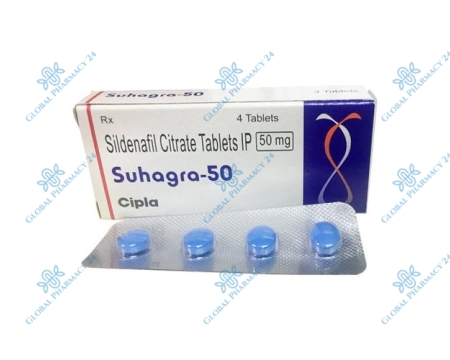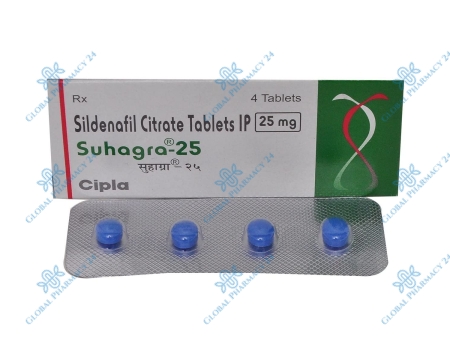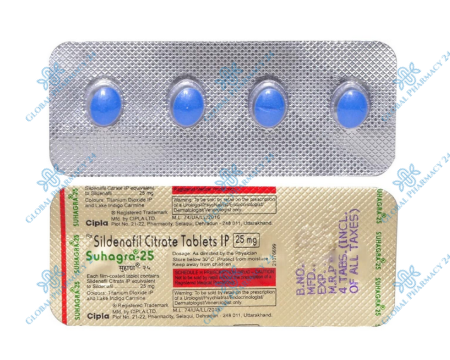Comprehensive Guide to Suhagra: Overview and Uses
Suhagra, a popular medication used for erectile dysfunction (ED), contains sildenafil citrate as its active ingredient. It's designed to help men achieve and maintain an erection sufficient for sexual activity. Sildenafil, also found in Viagra, belongs to a class of drugs known as phosphodiesterase type 5 (PDE5) inhibitors.
Primarily used for treating ED, Suhagra enhances blood flow to the penis during sexual stimulation, facilitating an erection. It's also occasionally used for pulmonary arterial hypertension (PAH) due to its vasodilatory effects, improving exercise capacity in both men and women with this condition.
Understanding Suhagra's Mechanism of Action
Suhagra operates by inhibiting PDE5, an enzyme that regulates blood flow in the penis. During sexual arousal, nitric oxide is released in the penile tissue, activating an enzyme called guanylate cyclase. This enzyme increases levels of a chemical called cyclic guanosine monophosphate (cGMP), which relaxes blood vessels and allows increased blood flow.
The inhibition of PDE5 by Suhagra enhances the effects of cGMP, thus maintaining an erection. This mechanism is effective only with sexual stimulation, as cGMP is only produced in response to sexual arousal, making Suhagra a targeted and effective treatment for ED.
Detailed Dosage Guidelines for Suhagra
The recommended starting dose of Suhagra for most men is 50 mg, taken about one hour before sexual activity. Depending on effectiveness and tolerance, this may be adjusted to a maximum recommended dose of 100 mg or decreased to 25 mg. It's important not to take Suhagra more than once a day.
To ensure safe usage, it should be taken on an as-needed basis and not used in conjunction with other ED treatments. Consultation with a healthcare provider is essential for those with pre-existing medical conditions or those taking other medications.
Various Strengths of Suhagra: A Comparative Analysis
Suhagra is available in multiple strengths: 25 mg, 50 mg, and 100 mg. The 25 mg dosage is typically for those who experience side effects with the 50 mg dose or have mild ED. The 50 mg dose is the standard starting dose, while 100 mg is prescribed for severe cases of ED or when lower doses are ineffective.
Choosing the right strength depends on individual tolerance, the severity of ED, and medical history. It's crucial to start with a lower dose and only increase under medical supervision to avoid potential side effects.
Essential Safety Information and Precautions
Before using Suhagra, it's important to discuss your medical history with a healthcare provider, especially if you have heart problems, a history of stroke, liver or kidney disease, high or low blood pressure, or a severe loss of body water (dehydration). Suhagra can cause a drop in your blood pressure when used with nitrates, which can lead to dizziness, fainting, and rarely heart attack or stroke.
Contraindications include patients with severe cardiac failure, arterial hypotension, or a recent history of stroke or myocardial infarction. It should not be used by women, children, or adolescents under the age of 18.
Potential Side Effects and How to Manage Them
Common side effects of Suhagra include headache, flushing, upset stomach, and nasal congestion. These are usually mild and temporary. Rare side effects may include changes in vision, sudden loss of vision, hearing problems, or prolonged and painful erections (priapism).
If side effects are bothersome or persist, it is advised to consult a healthcare provider. In case of priapism, immediate medical attention is required. Adjusting the dosage or switching to another medication may be necessary based on side effects.
Interactions with Other Medications
Suhagra can interact with several medications, particularly nitrates used for chest pain, certain blood pressure medications, and alpha-blockers. It also interacts with some HIV protease inhibitors, some types of antifungals, and other medications for ED.
It's critical to inform your healthcare provider about all the medications you're taking, including over-the-counter drugs and herbal supplements, to avoid potential interactions. Combining Suhagra with other treatments for ED is not recommended.
Special Considerations for Specific Populations
In elderly patients, a lower starting dose of Suhagra may be considered due to the potential for higher sensitivity to the medication. Women are not typically prescribed Suhagra, but in cases of PAH, different dosing considerations may apply.
For those with kidney or liver impairment, dosage adjustments are necessary. Caution is advised when prescribing Suhagra to patients with underlying cardiovascular risk factors.
Storing Suhagra: Best Practices
Suhagra should be stored at room temperature, away from light and moisture. It's important not to store it in the bathroom or areas prone to humidity. Keeping it out of reach of children and pets is essential for safety.
Proper storage ensures the medication's effectiveness and integrity. Expired or no longer needed medication should be disposed of properly, following the guidelines provided by a pharmacist or local waste disposal company.
Answering Your Questions: FAQs
Common questions about Suhagra include inquiries about how long it takes to work, how long the effects last, and dietary restrictions while taking it. Typically, Suhagra starts working within 30 to 60 minutes and its effects can last for up to 4 hours. It is advisable to avoid heavy meals and alcohol when taking Suhagra, as they can delay its effects.
- What is Suhagra and what is it used for?
Suhagra is a medication containing sildenafil citrate, primarily used for treating erectile dysfunction. How does it aid in sexual performance? - How does Suhagra work in the body?
What is the mechanism of action of Suhagra and how does it help in achieving an erection? - What are the recommended dosages for Suhagra?
What is the standard starting dose and how can it be adjusted according to individual needs? - How should Suhagra be taken safely?
Are there any specific instructions or precautions for taking Suhagra? - What are the different strengths of Suhagra available?
How do these strengths vary and who are they suitable for? - What are the key safety advice and precautions for Suhagra?
What should patients be aware of before taking Suhagra? - What are the common side effects of Suhagra?
What side effects can users expect and how severe can they be? - How should side effects of Suhagra be managed?
What steps should be taken if one experiences side effects? - Can Suhagra interact with other medications?
What are the known drug interactions with Suhagra? - Are there any special considerations for specific populations using Suhagra?
How should elderly patients or those with certain medical conditions approach using Suhagra?

























